The .300 Win Mag and 7mm Rem Mag cartridges hit the market around the same time and are both hugely popular in the hunting and shooting communities. Even so, they have different strengths and weaknesses and the 7mm Rem Mag vs 300 Win Mag debate is still going strong over 50 years later.
I think most hunters would agree that the 7mm Remington Magnum and .300 Winchester Magnum are both fantastic cartridges for hunting a wide variety of big game. That being said, even though they have a lot in common, and even though there is a big overlap in their capabilities, many hunters and shooters love to debate the pros and cons of the 7mm Rem Mag vs 300 Win Mag.
There’s absolutely nothing wrong with that, but sometimes important details about the cartridges get overlooked or simply lost in the shuffle. With that in mind, it’s easy to see how many people get confused about the strengths and weaknesses of the .300 Winchester Magnum and 7mm Remington Magnum, particularly when discussing which cartridge is best for hunting particular animals under specific conditions.
In this article, I’m going to dive right into the 7mm Rem Mag vs 300 Win Mag debate in order to provide you with the necessary information to decide which cartridge you should be using in various situations.
Before we get started, I have an administrative note:
Some of the links below are affiliate links. This means I will earn a small commission (at no extra cost to you) if you make a purchase. This helps support the blog and allows me to continue to create free content that’s useful to hunters like yourself. Thanks for your support.
Additionally, I recorded an entire podcast episode on this exact subject. If you’d rather listen than read, click the appropriate link below to listen to this episode on your preferred podcasting service.
300 Win Mag vs 7mm Rem Mag Podcast
Apple | Google | iHeart | Pandora | Spotify
.300 Win Mag vs 7mm Rem Mag: History
Though the .270 Winchester and .30-06 Springfield are both wonderful cartridges that have been incredibly popular with hunters since they were first introduced at the beginning of the 20th Century, gun designers never stopped looking for ways to improve upon the performance of those two old war horses. This was particularly true for the .30-06 Springfield, which has long been the standard against which new centerfire rifle cartridges are measured against in the United States.
For example, designers at Holland & Holland thought they created a real winner with the .300 H&H Magnum in the 1920s. For one thing, the cartridge enabled shooters to fire the same weight bullet a couple hundred feet per second faster than the .30-06 Springfield could. At the same time, it was also extremely accurate (Ben Comfort famously won the 1935 Wimbledon Cup using the cartridge).
Unfortunately, the .300 H&H Magnum was so long that it required the use of a magnum length action. So while the cartridge was moderately popular among shooters and hunters prior to World War II, the outsized length of the .300 H&H hampered more widespread acceptance of the cartridge and contributed to its decline in popularity during the ensuring decades.
Civilian firearm and cartridge development really slowed down during World War II, but the major gun manufacturers released a flood of new hunting cartridges in the following years.
This time period saw a wave of new belted magnum cartridges based on the .375 H&H Magnum (like the .264 Winchester Magnum, .338 Winchester Magnum, and .458 Winchester Magnum).
All of those cartridges saw varying degrees of commercial successes, but the best was still yet to come.
Norma made a big splash when they rolled out the .308 Norma Magnum in the early 1960s. The new cartridge essentially duplicated the ballistics of the .300 H&H Magnum, but used a much shorter case that allowed the cartridge to fit in a standard length action. For those reasons, the .308 Norma was extremely popular for a short time.
Remington changed the shooting world forever in 1962 when they introduced their legendary Remington Model 700 rifle along with the brand new 7mm Remington Magnum cartridge. Using a shortened .375 H&H Magnum case paired with a .284″ bullet, the 7mm Remington Magnum (often referred to as the 7mm Rem Mag, 7mm RM, or 7mm Mag) offered a significant ballistic improvement over the .30-06.
Indeed, the 7mm Mag will shoot the same weight bullet faster than the .30-06. Additionally, the smaller diameter .284″ bullets the 7mm Mag uses have a higher ballistic coefficient and more sectional density than .30 caliber bullets of the same weight used by the .30-06 Springfield. For those reasons, typical 7mm Rem Mag loads have a flatter trajectory, more energy remaining downrange, and (all other things equal) will penetrate better than .30-06 Springfield loads using the same weight bullets.
And to top it all off, the new 7mm Remington Magnum cartridge fit in a standard length rifle action.
With all that in mind, it’s not surprising at all that the flat shooting and hard hitting 7mm Rem Mag quickly caught on with hunters and shooters in North America.
Designers at Winchester during that timeframe could see what direction the wind was blowing and they began work on a .30 caliber cartridge built along the same lines as their other belted magnums. They even used the case from the .338 Winchester Magnum (which was itself descended from the .375 H&H) as a model for the new cartridge.
The company formally introduced the fruits of their labor to the world in 1963: the .300 Winchester Magnum (also known as the .300 Win Mag, .300 WM, .300 Mag, or .300 Winchester, but not to be confused with its cousin the 300 WSM). Like the .308 Norma, the .300 Winchester Magnum essentially duplicated the performance of the .300 H&H Magnum in a shorter case that fit in a standard length rifle action. In fact, the .308 Norma and .300 Winchester Magnum are both very similar in terms of performance or overall cartridge size.
Even so, the advent of the .300 Winchester Magnum resulted in a sharp decline in popularity of the .308 Norma for two primary reasons. First, the new cartridge was available in the venerable Winchester Model 70 rifle. Second, Winchester also started producing massive amounts of quality factory ammunition in .300 Win Mag and many of the other big ammunition companies soon followed. Since .308 Norma rifles and factory ammo were much less common than in North America, the new Winchester cartridge quickly overtook and eventually replaced the .308 Norma in that market.
That’s not to diminish the capabilities of the .300 Winchester Magnum at all. On the contrary, it’s a fantastic cartridge that’s extremely popular for good reason.
Due to its advantage in case capacity, the .300 Win Mag has a noticeably flatter trajectory along with approximately 20% more energy than the .30-06 Springfield. Though both cartridges utilize .308″ bullets, the .300 Win Mag is also better suited for using heavier bullets in the 200-220 grain range than the .30-06. Additionally, it’s an extremely accurate cartridge that may even have a slight edge on the .30-06 in that regard.
For an in-depth discussion on the .300 Winchester Magnum and how it stacks up to the .308 Winchester, the .30-06 Springfield, the .338 Winchester Magnum, and the .338 Lapua Magnum, read the articles below:
308 vs 30-06 vs 300 Win Mag: Which Cartridge Should You Be Hunting With?
300 Win Mag vs 338 Lapua vs 338 Win Mag: Picking The Right Heavy Hitter
In short, like the 7mm Rem Mag, the .300 Win Mag is an excellent cartridge that packs more performance than the .30-06 Springfield into a comparably sized package.
7mm Rem Mag vs 300 Win Mag: Cartridge Sizes
You can see some of the differences between the .300 Winchester Magnum and 7mm Remington Magnum cartridges in the photo below. Both cartridges are belted magnums that utilize modified .375 H&H Magnum cases. For that reason, both cartridges have the same rim diameter. The .300 Win Mag has a slightly greater overall length (3.34″ vs 3.29″), but they are close enough in size that both cartridges are used in standard/long-action rifles.
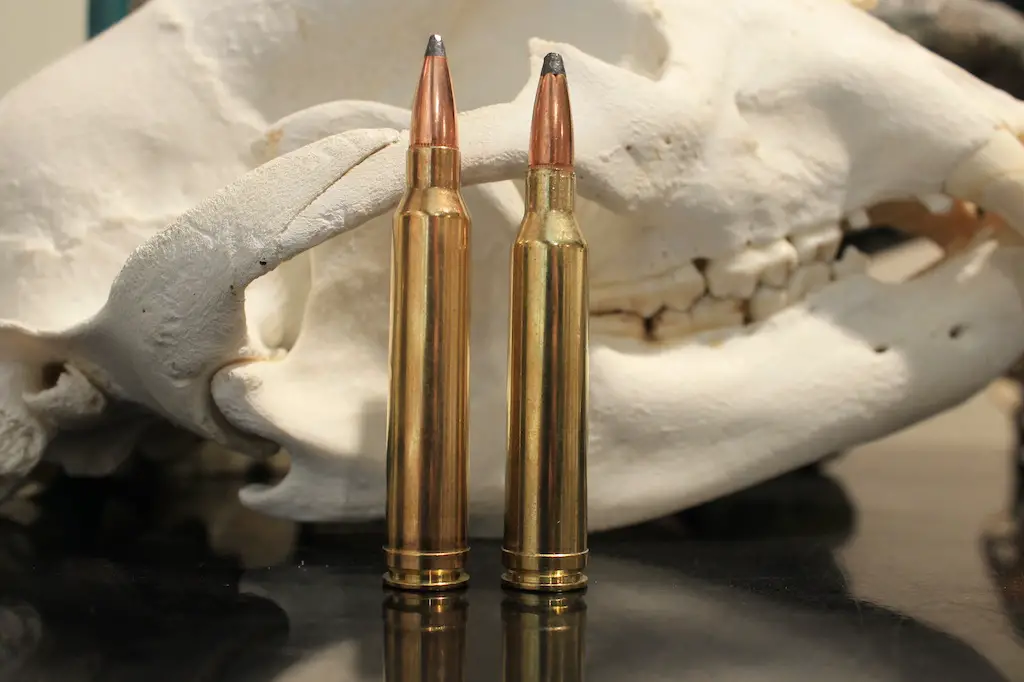
On the other hand, the .300 Winchester Magnum has a slightly longer case length (2.62″ vs 2.5″) as well as a shoulder that sits .156″ further forward than the shoulder of the 7mm Rem Mag. Though they both have the same rim diameter and are very similar in overall length, the longer case length and advantage of the shoulder placement on the .300 Win Mag gives that cartridge a 5-8% advantage in capacity over the 7mm Rem Mag.
Note: while the case capacity figures listed below do give a good indication of the differences between the two cartridges, exact case capacities vary slightly according to the brand of brass used.

.300 Win Mag vs 7mm Rem Mag Ballistics
As you’d expect from the fact that the two cartridges are very similar in overall size, the ballistics of the 7mm Rem Mag and .300 Win Mag are pretty similar.
The biggest difference between the two cartridges is the size and weight of the bullets they fire though: the 7mm Remington Magnum uses .284″ bullets and the .300 Winchester Magnum uses .308″ bullets.
Everything else being equal, the smaller diameter 7mm bullets have a higher ballistic coefficient and a higher sectional density than the larger diameter bullets of the same weight from the .300 Winchester Magnum.
However, the .300 Winchester Magnum generally uses heavier bullets than the 7mm Remington Magnum.
For instance, the vast majority of 7mm Rem Mag factory loads shoot bullets in the 139-175 grain range. Of these, 140 grain, 150 grain, 160 grain, and 175 grain loads are by far the most common.
The heaviest bullet used in commercially loaded 7mm Remington Magnum ammo is the 195 grain Berger Extreme Outer Limits. It’s worth noting that this ammunition is not very common and not every 7mm Rem Mag rifle can accurately shoot bullets that heavy though: a 1:9″ twist rate is required for this 195gr Berger bullet and SAAMI spec for the 7mm Rem Mag is a little bit slower at 1:9.5″.
On the other hand, most .300 Win Mag factory loads use bullets in the 150-230 grain range. 150 grain, 165 grain, 180 grain, 190 grain, 200 grain, and 220 grain bullets are the most popular.
All that being said, the 7mm Rem Mag still has a slight edge with most bullets in common use, even when compared to heavier .30 caliber bullets. For instance, the 150gr Barnes TTSX and 168gr Nosler AccuBond Long Range bullets in 7mm Rem Mag have G1 ballistic coefficients of .450 and .631 respectively while the 165gr TTSX and 190gr Nosler AccuBond Long Range in .300 Win Mag have ballistic coefficients of .442 and .597.
As you can see in the table below comparing those four loads, the .300 Win Mag has a small edge, but there isn’t a gigantic difference in the ballistics of the cartridges.
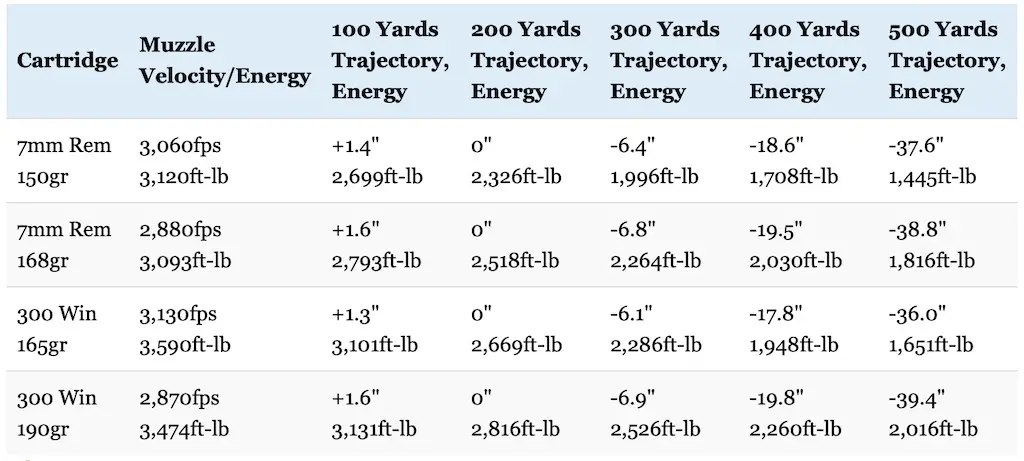
The .300 Win Mag does have slightly less bullet drop and carries more energy down range. This is due in large part to the fact that the cartridge uses heavier bullets and has more case capacity. However, since the 7mm Mag bullets compared above have a slightly higher ballistic coefficient, the gap in kinetic energy between the two bullets closes slightly at longer ranges.
The table below compares how much a 10 mile per hour crosswind impacts those same 4 loads out to 500 yards.
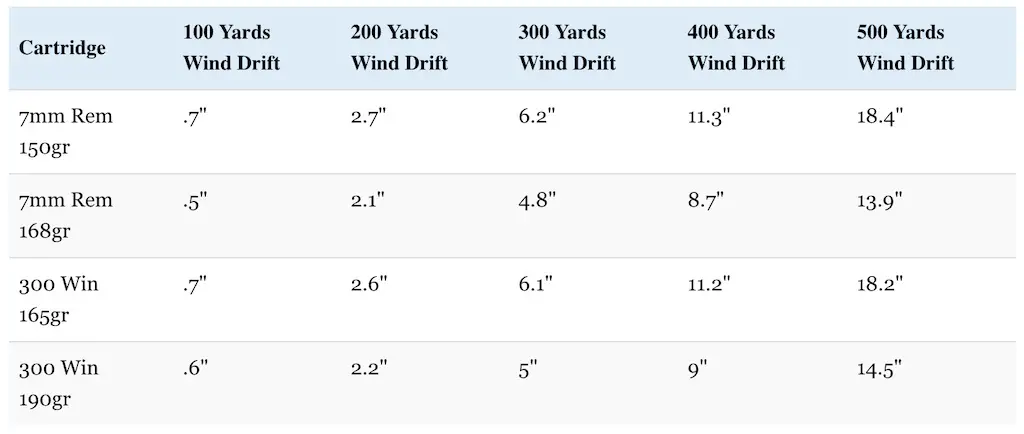
The two Barnes loads have almost an identical amount of wind drift, but the 7mm Rem Mag Nosler AccuBond load has a slight edge over the .300 Win Mag AccuBond load. For all practical purposes though, there isn’t a significant difference in the ballistics of the .300 Win Mag and 7mm Rem Mag at typical hunting ranges. They’re both flat shooting and hard hitting cartridges.
That being said, the .300 Win Mag has noticeably more recoil than the 7mm Rem Mag.
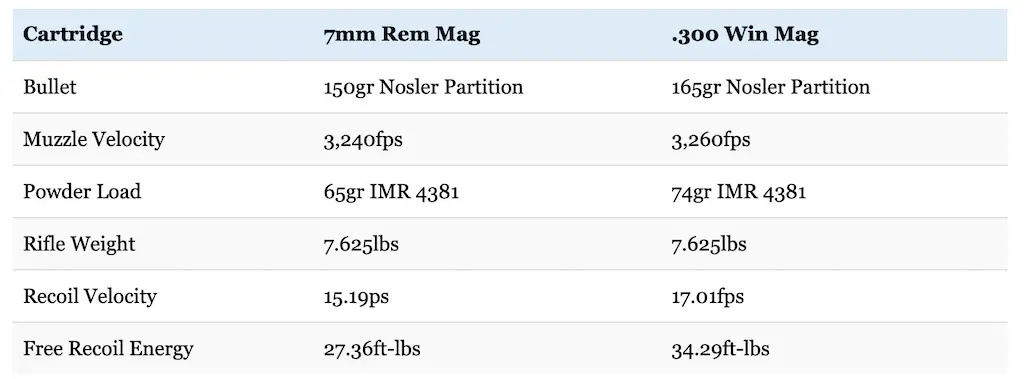
For example, when fired from the exact same rifle, a .300 Win Mag load firing a 165 grain bullet has about 25% more recoil than a 7mm Rem Mag load firing a 150 grain bullet at a similar muzzle velocity. That being said, both cartridges have a moderate recoil that most shooters should be able to handle.
Felt recoil will vary from shooter to shooter and rifle to rifle, but free recoil energy is still a useful way to compare the two cartridges.
Gun writers have spilled a lot of ink comparing the accuracy of the 7mm Rem Mag vs 300 Win Mag over the years. While picking the most accurate cartridge of the two is a relatively contentious subject, most people agree that both the 7mm Mag and .300 Mag are capable of excellent accuracy.
Not surprisingly, both cartridges have seen extensive use in long range shooting competitions and both are in common use among military and police snipers for precision shooting.
7mm Rem Mag vs 300 Win Mag: Ammunition Selection
The .300 Win Mag and 7mm Rem Mag are both extremely popular magnum cartridges and consistently rank among the best selling rifle cartridges in the USA each year. For that reason, virtually every ammunition manufacturer of note like Barnes, Berger, Black Hills, Browning, Federal Premium, Hornady, Nosler, PPU, Remington, Swift, Weatherby, and Winchester produces a wide array of high quality 7mm Rem Mag and .300 Win Mag factory ammunition.
Just about every major style of bullet is available in those cartridges as well like the Barnes TTSX, the Berger VLD, the Hornady ELD-X, GMX, InterBond, InterLock, and SST, the Nosler AccuBond, E-Tip, and Partition, the Remington Core Lokt, the Swift Scirocco and A-Frame, and the Winchester Power Point (just to name a few).
Prices and availability for vary from region to region, but ammunition for both cartridges is widely available and similarly priced as well.
BUY SOME QUALITY 7mm REM MAG AMMO HERE
BUY SOME GREAT 300 WIN MAG AMMO HERE
Read the articles below if you’d like to learn more details about some of the various hunting ammunition choices for the 7mm Remington Magnum or the .300 Winchester Magnum.
Best 7mm Remington Magnum Ammunition For Hunting Deer, Elk, & Other Big Game
Best .300 Winchester Magnum Ammunition For Hunting Elk, Deer, Moose, & Other Big Game
At the same time, reloading components for both cartridges are also widely available. Since they are such popular bullet sizes used by other cartridges like the 7mm-08 Remington, .280 Ackley Improved, .308 Winchester, and .30-06 Springfield, and 30o PRC, there are lots and lots of .284 and .308 caliber bullets of varying weights and styles to choose from, so you shouldn’t have much trouble working up a custom load that shoots very accurately in your chosen rifle.
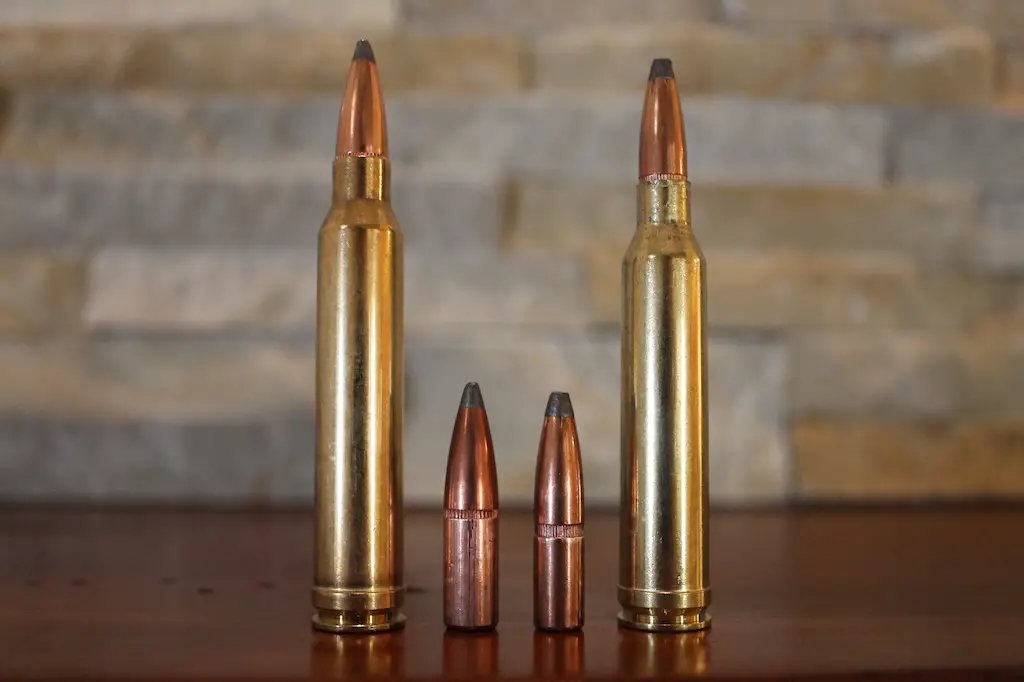
.300 Win Mag vs 7mm Rem Mag: Rifle Selection
Along with lots of choices for ammunition, there is an abundance of great hunting rifles produced by nearly every big firearms manufacturer chambered in 7mm Remington Magnum and .300 Winchester Magnum. Additionally, because the cartridges are the same length and have the same rim diameter, rifles of the same model chambered in each cartridge are virtually identical to each other.
Among others, the Remington Model 700, Browning X-Bolt, CZ-550, Mossberg Patriot, Nosler M48, Ruger M77 Hawkeye, Savage 11/111, Thompson Center Compass, Tikka T3X, Weatherby Mark V and Vanguard, and the Winchester Model 70 are all available in 7mm Remington Magnum and .300 Winchester Magnum.
BUY A DEPENDABLE 7mm REM MAG RIFLE HERE
BUY AN EXCELLENT 300 WIN MAG RIFLE HERE
Read the article below if you’d like to learn more details about some of the various hunting rifle choices for the .300 Winchester Magnum.
Best .300 Win Mag Rifles For Hunting – Ultimate Guide
7mm Rem Mag vs 300 Win Mag: Which Is Right For You?
When using quality bullets and with good shot placement, both the 7mm Rem Mag and .300 Win Mag are excellent for hunting medium to large sized game at virtually all practical hunting ranges. Both cartridges are flat shooting, heavy hitters with over 3,000 ft-lbs of energy at the muzzle and are suitable for hunting most big game up to and including moose and Alaska brown bear.
However, they really shine in situations where hunters need a flat shooting cartridge for taking shots out past 200-300 yards. For that reason, the 7mm Rem Mag and .300 Win Mag are both very popular among hunters in the western United States.
At the same time, they’re not limited to long range hunting applications. Indeed, the fact that 7mm Remington Magnum and .300 Winchester Magnum are two of the most popular cartridges used by North American and New Zealand hunting guides really says a lot about their effectiveness on a wide variety of big game from feral hogs to moose.
However, this is where the strengths and weaknesses of each cartridge start to diverge though.
The smaller caliber 7mm Remington Magnum is wonderful for smaller and lighter animals like mule deer, pronghorn, or fallow deer. By the same token, the fact that the 7mm Remington Magnum also has a relatively mild recoil also makes it a great cartridge for mountain hunts where a lightweight rifle is really desirable, like mountain goat, bighorn sheep, Himalayan Tahr, and chamois hunting.
On the other hand, since it shoots heavier and larger diameter bullets, the .300 Win Mag has a clear advantage when hunting larger game like elk, moose, caribou, and red stag. It’s also an excellent cartridge for hunting most species of African plains game.
Don’t get me wrong, you can absolutely hunt really big species like elk or moose with the 7mm Rem Mag and hunters have cleanly killed untold numbers of those animals with the venerable 7mm Mag over the years. There’s also nothing saying the .300 Win Mag isn’t suitable for smaller animals or that can’t also be a great rifle for a mountain hunt.
Like I said earlier, they’re both quite versatile, but each cartridge is just a better choice for certain applications. The fact that I have to nitpick the strengths and weakness of each cartridge like that really speaks to their overall effectiveness.
Do you primarily hunt deer, hogs, or black bear in an area where long distance shots past 200 yards are uncommon and bullet drop isn’t a big concern? Both the 7mm Rem Mag and .300 Win Mag will work just fine under these circumstances and there isn’t much of a difference between them ballistically inside of 300 yards.
Are you sensitive to recoil? Do you spend a lot of time in the mountains or the backcountry mountain goat, sheep, or tahr hunting where it’s really nice to have a lightweight rifle? Consider going with the 7mm Rem Mag, which has a lighter recoil that’s more manageable in a small and light rifle.
Do you want an ideal cartridge for moose, elk, kudu, eland, and/or red stag hunting? Both cartridges will do the job, but the .300 Win Mag offers a clear advantage since it has a larger diameter and can use heavier bullet weights that are much better suited for extremely large and/or tough game.
Do you hunt in Canada or Alaska and need a heavy hitting cartridge just in case you find yourself on the wrong end of a brown or grizzly bear attack? Neither cartridge would be my first choice for facing down an angry grizzly bear, but they’d both work in a pinch. However, I’d prefer the .300 Win Mag with 180 grain bullets over the 7mm Mag in that situation.
As I’ve stated many times: the 7mm Remington Magnum and .300 Winchester Magnum are both outstanding rifle cartridges. While each one may be better suited to specific situations than the other, they are both excellent cartridges overall. The difference between them (7mm Rem Mag vs 300 Win Mag) isn’t as great as it is sometimes made out to be and the animal will never know the difference if your shot is placed in the right spot.
Are you itching to take a rifle chambered in one of these cartridges on a hunt?
Book a great black bear hunt here.
Book an incredible African safari hunt here.
Enjoy this article about the 7mm Rem Mag vs 300 Win Mag debate? Please share it with your friends on Facebook and Twitter.
Nosler provided the load data used to compare trajectory, case capacity, and recoil for the cartridges (here and here). Cartridge case capacities were obtained from Chuck Hawks. The Lyman 50th Edition (p214-216 & 260-262), and Hornady 10th Edition (p406-411, 537, 545, & 574-585) reloading manuals were also used as references for this article. I used the Hornady Ballistic calculator and Handloads.com to compare wind drift and recoil for the cartridges.
Make sure you follow The Big Game Hunting Blog on Facebook, Instagram, Twitter, and YouTube.
NEXT: BEST 6.5 CREEDMOOR AMMO FOR HUNTING ELK, DEER, & OTHER BIG GAME
NEXT: 101 BEST GIFTS FOR HUNTERS
John McAdams is a proficient blogger, experienced shooter, and long time hunter who has pursued big game in 8 different countries on 3 separate continents. John graduated from the United States Military Academy at West Point and is a veteran of combat tours with the US Army in Iraq & Afghanistan. In addition to founding and writing for The Big Game Hunting Blog, John has written for outdoor publications like Bear Hunting Magazine, The Texas State Rifle Association newsletter, Texas Wildlife Magazine, & Wide Open Spaces. Learn more about John here, read some of John’s most popular articles, and be sure to subscribe to his show: the Big Game Hunting Podcast.

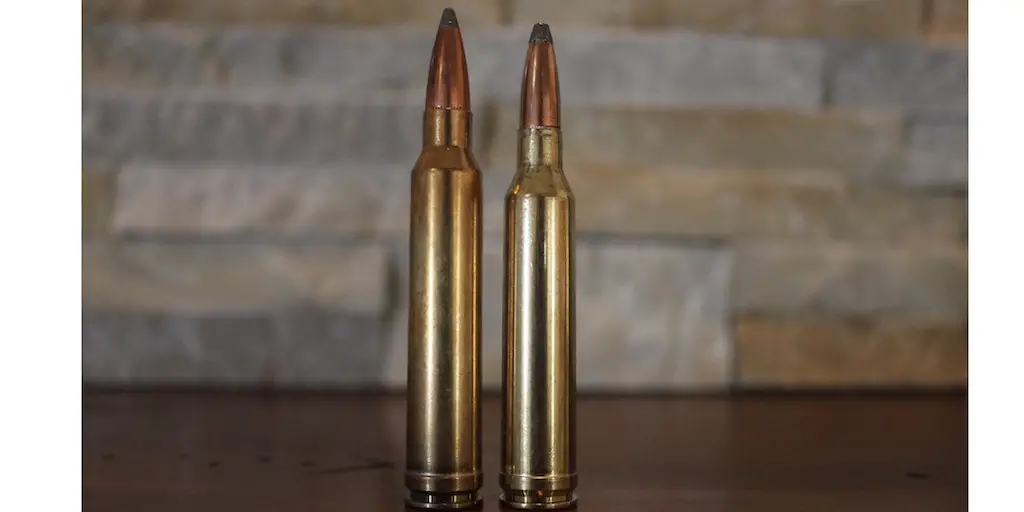

Ooh what a beautiful article indeed.Im from Botswana and we shoot flat plains. I’ve been shooting. 300 win mag from age 19 and now turning 42 . So I’m thinking about getting myself the 7mm mag for the less recoil. But I’m worried if the 7mm will take down a 500kg eland at 200 yards?. Thanks
Hi Noshad.
Glad you found this article useful! The 7mm Mag will work just fine on eland if you use the right bullets, like a 160gr Nosler Partition or Barnes TSX. I personally would prefer to use a .300 Win Mag on an eland, but that’s just me and plenty of people use the 7mm Magnum on really big game like moose and eland with lots of success each year.
John
I live in South Africa and have hunted various species with my Winchester 7mm RM over the last 20 years: Kudu, Gemsbuck, Blue Wildebeest, Impala, Springbuck, Blesbuck, Warthog all taken down with one shot, up to a distance of 300 metres, but mostly around 100 metres in the bushveld. I once shot an Eland with the 7mm RM, but that took two shots (but the shot placement on shot no. 1 was not great). I will feel more comfortable with a slightly heavier calibre for Eland. I use mainly over the counter Remington 175 grain rounds.
Owned 7mm Remington Mags and 300 Winchester Mags over the years. Sold the 300’s and kept the 7mm’s mainly because of the 300’s recoil wasn’t worth the difference in performance and as a prairie deer and antelope hunter the 7mm was a better fit. But in truth I use 25-06’s and 270’s more often since they are more than adequate for my needs
I’ve had a 7mag for 40 years, still love it ! Had a 300 Weatherby mag for a couple years , sold it. The difference in recoil and the price of ammo and not much performance difference (in my humble opinion) made the decision. Plus the 300 was like carrying around a stick of firewood in the woods to an aging old man . Great article. Thanks and GOD bless! 🙏🏻
lol..well this old feller got gifted a 7mm in a older Sako 955. Its a sweet shooter yes, but I wouldn’t want to lug that beast in the bush all day.
Great article! Personally considering purchasing a 300WM but after reading the article I think I’ll stick with my 7MM. Just returned from taking a carribou at 324yrds with my savage and bench time/shot placement means everything. One shot one kill. Thanks for the comparison.
have hunted with both the 300 wm and the 7 mag over the last 50 years along with others and my first pick on most hunts has been the 7mm i have taken almost all game species in the usa and have found no real differnce between the two but the 7 kicks less costs less with most ammo brands and my 7mm rifle weighs 1 1/2 lb less my hunts have been aprox 70% 7mm 30% 300 wm my go to bullet has been the Barnes tsx in all my rifles for over 15 years now I have complete confidence in its ability to get the job done